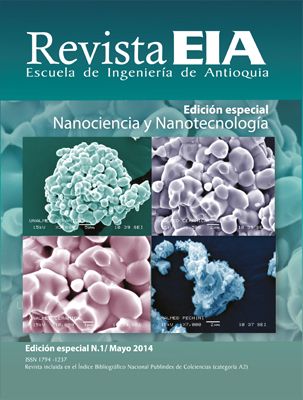Medidas de transmitancia espectral sin la presencia de franjas de interferencia: un modelo para la obtención de las constantes ópticas en películas delgadas semiconductoras
Medidas de transmitancia espectral sin la presencia de franjas de interferencia: un modelo para la obtención de las constantes ópticas en películas delgadas semiconductoras


This work is licensed under a Creative Commons Attribution-NonCommercial-NoDerivatives 4.0 International License.
Copyright statement
The authors exclusively assign to the Universidad EIA, with the power to assign to third parties, all the exploitation rights that derive from the works that are accepted for publication in the Revista EIA, as well as in any product derived from it and, in in particular, those of reproduction, distribution, public communication (including interactive making available) and transformation (including adaptation, modification and, where appropriate, translation), for all types of exploitation (by way of example and not limitation : in paper, electronic, online, computer or audiovisual format, as well as in any other format, even for promotional or advertising purposes and / or for the production of derivative products), for a worldwide territorial scope and for the entire duration of the rights provided for in the current published text of the Intellectual Property Law. This assignment will be made by the authors without the right to any type of remuneration or compensation.
Consequently, the author may not publish or disseminate the works that are selected for publication in the Revista EIA, neither totally nor partially, nor authorize their publication to third parties, without the prior express authorization, requested and granted in writing, from the Univeridad EIA.
Show authors biography
En este trabajo presentamos un modelo para la obtención de las constantes ópticas de películas delgadas semiconductoras cuando no es posible observar franjas de interferencia en los espectros. La obtención de las cons- tantes ópticas como el coeficiente de absorción (α), el índice de refracción (n), coeficiente de extinción (k) y las propiedades físicas como el ancho de brecha prohibida «Gap» (Eg) y el espesor de la película (d), fueron obtenidos para películas delgadas del compuesto Cu2ZnSnSe4 mediante la deconvolución de los espectros experimentales. Para el análisis de las medidas de transmitancia se tomó como base modelo de Bhattacharyya y elementos básicos de la teoría de Sweneapoel. El modelo aquí presentado tiene en cuenta consideraciones de inhomogeneidad en la película y rugosidad en la superficie. Los valores para las constantes ópticas obtenidas por el modelo propuesto presentaron concordancia con los obtenidos para las muestras a partir de la teoría de Sweneapoel, cuando fue posible su aplica- ción. Una variación del ± 6 % fue observada para los valores del espesor, los cuales fueron corroborados mediante la realización de medidas de perfilometría.
Abstract: This paper presents a model for obtaining the optical constants of thin films semiconductors. It is possible when there are not interference fringes in the transmittance spectra. Optical constants as the absorption coefficient (α), refrac- tive index (n), extinction coefficient (k) and other physical properties (Gap (Eg) and thickness (d)) were obtained for the Cu2ZnSnSe4 compound by deconvolution experimental spectra. Bhattacharyya model and basic elements of Swanepoel theory were used for analysis of transmittance measurements. TheModel presented takes into account considerations of inhomogeneity in the film and surface roughness. Values for the optical constants obtained by the proposed model showed agreement with those obtained for samples from Swanepoel theory, when its implementation was possible. A variation of ± 6 % for thickness values, which were corroborated by performing profilometry measurements, was observed.
Article visits 265 | PDF visits 132
